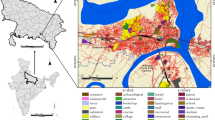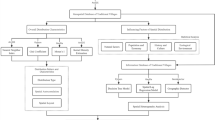Abstract
Tibetan Buddhism is of vital significance to Buddhism as a whole. In traditional Chinese history, Tibetan society has always implemented a theocratic political system. Tibetan Buddhism permeates through all aspects of Tibetan social life. Monasteries are places for monks to preach Dharma and are carriers of Tibetan Buddhist culture. The spatial pattern of a monastery is the result of multiple factors. Therefore, analysis of the spatial patterns and influencing factors of the monasteries provides a basis for further analysis of the evolutionary laws and diffusion patterns. As the Amdo Tibetan area is located in the buffer zone between the Tibetan inhabited regions and the Central Plains, the religious and cultural development in this area has distinct regional characteristics. Based on the basic geographic data of monasteries obtained from literature review and field investigation, this article uses spatial analysis methods such as kernel density analysis, standard deviation ellipse analysis, and GWR in GIS to qualitatively and quantitatively analyze the spatial distribution characteristics and driving factors of Tibetan Buddhist monasteries in the Amdo Tibetan inhabited regions. The results show that the general distribution of the monasteries represents a spatial agglomeration pattern of “one belt and two centers.” Under the multicentered spatial pattern of Buddhist monasteries, the monastery spatial distribution of various sects has obvious regional differentiation characteristics. Apart from historical population data, the factor that has the greatest impact on the distribution of Tibetan Buddhist monasteries is distance to the river, and elevation has a negative correlation with the monastery density. The coupling relationship between different sects affects the distribution of monasteries in Tibetan inhabited regions.












Similar content being viewed by others
References
Bartkowski JP, Howell FM, Lai S-C (2002) Spatial variations in church burnings: the social ecology of victimized communities in the south. Rural Sociol 67(4):578–602
Brunsdon C, Fotheringham AS, Charlton ME (2010) Geographically weighted regression: a method for exploring spatial nonstationarity. Geogr Anal 28(4):281–298
Carus P (1902) Nirvana: a story of buddhist psychology. Kessinger Pub
Chao Z, Zhao Y, Liu G (2021) Multi-scale spatial patterns of Gelugpa monasteries of Tibetan Buddhism in Tibetan Inhabited Regions. GeoJournal, China. https://doi.org/10.1007/s10708-021-10501-7
Da H (1995) The worldwide influence of Tibetan Buddhism. Tibetan Art Studies 1995(4):76–78
Dang (1982) Statistics of China's historical household registration, fields, and land taxes. Read 1982(6): 64.
Dong L (2013) Symbolic representation and practice of space in religious culture Ph.D. dissertation, Minzu University of China
Gao X (2010) The formation of Anduo and Kang area and the origion of the ethnic groups. J Sichuan Minzu Coll 19(6):14–18
Gao X (2011) A summary of the research on Tibetan History in Amdo and Kham during the Ming and Qing Dynasties in the past ten years. J Aba Teach Coll 28(3):16–22
Gao X (2012) The 21st century study on Tibetan History in Anduo and Kang Area in Ming and Qing Dynasties. J Qinghai Nationalities Institu (Social Sciences) 38(1):16–22
Gao Y, Mary P (2010) The influence of Tibetan Buddhism on western psychology. China Tibetology 1:66–70
Hultkrantz Ä (1966) An ecological approach to religion. Ethnos 31(1–4):131–150
Jin Q, Gen X (2012) The spatial distribution of religion in Xi’an. Beijing Planning Review 2012(5):99–102
Kiskowski MA, Hancock JF, Kenworthy AK (2009) On the use of Ripley’s K-function and its derivatives to analyze domain size. Biophys J 97(4):1095–1103
Kong L (1990) Geography and religion: trends and prospects. Prog Hum Geogr 14(3):355–371
Kong L (2001) Religion and technology: refiguring place, space, identity and community. Area 2001(33):404–413
Li Q (2001) The relationship between Tibetan Buddhism and Chinese traditional culture. China Tibetology 2001(3):67–71
Li S (2013) Time and space distribution of Gelug Sect of Tibetan Buddhism monasteries in Northern Tibetan-Yi Corridor and its features in the Qing Dynasty. J Northwest Univer (Social Sciences) 50(4):79–83
Liu X (2003) A study of inter-ethnic relationship and regional culture in Amdo Tibetan inhabited regions. National Publishing House, China
Long-Zhu-Duo-Jie (2011) Study on the monastic architecture culture of Tibetan Buddhis. Ph.D. dissertation , Minzu University of China
Lu X, Wang G, Hu W (2019) Study on the spatial pattern of religious landscape in Shanxi Province). World Reg Stud 28(2):217–224
Naylor S, Ryan JR (2002) The mosque in the suburbs: negotiating religion and ethnicity in South London. Soc Cult Geogr 3(1):39–59
Park C (2020) Religion and geography. Enlightened Entrepreneurialism.
Pu W (1990) Overview of Tibetan Buddhist monasteries in Qinghai. Qinghai Social Sciences 1990(5):92–99
Shawe-Taylor J, Cristianini N (2004) Kernel methods for pattern analysis, Taylor & Francis Group
Sopher D (1981) Geography and religions. Prog Human Geogr 1981(5):510–524
Tang J, Wang L, Ma Y (2021) Spatial pattern evolution of Tibetan Buddhist Temple in Hengduan Mountain Area l. Res Dev 40(5):169–173+180
Walsh R, Shapiro SL (2006) The meeting of meditative disciplines and Western psychology: a mutually enriching dialogue. Am Psychol 61(3):227–239
Wang K (2011) Study on the spatial distribution and characteristics of Sakya monasteries of Tibetan Buddhism in Kham Tibetan inhabited regions in historical period. Religious Studies 2011(3):178–183
Wang T (2020) Research on population geography of Amdo Tibetan inhabited regions in Ming Dynasty. Master Thesis, Northwest Minzu University
Wang L, Yang H (2017) Social life in modern Amdo Tibetan area and analysis of Tibetan Buddhism. Religious Studies 2017(2):167–175
Wang K (2009) Study on the historical geography of Tibetan Buddhism in Kham Tibetan inhabited regions (8th century AD-1949). Ph.D. dissertation, Jinan University
Xue X, Zhu H (2008) The evolution of missionary case in space and time in Guangdong (1584–1910). Geogr Res 2008(3):693–702
Yang Q, Fan X (2019) Zhagana Tibetan village in Diebu county, Gansu Province. Inter Des Constr 2019(1):122–125
Zhu P (2006) The research of the historical-cultural geography of the Tibetan Buddhism in Qinghai. Ph.D. dissertation, Shaanxi Normal University
Zhu P (2009) Time and spatial distribution of Qinghai’s Tibetan Buddhism monasteries in Yuan Dynasty. J Qinghai National Inst (Social Sciences) 35(2):8–14
Zhu P (2010) The spatial and temporal distribution of Tibetan Buddhism monasteries of Ming in Qinghai. J Xizang Minzu Univ (Philos Soc Sci Ed) 31(5):32–35+138
Funding
This study was funded by the Humanities and Social Sciences Foundation of the Ministry of Education of the People’s Republic of China (No. 18YJAZH140).
All the procedures performed in this study involving human participants were in accordance with ethical standards.
Author information
Authors and Affiliations
Corresponding author
Ethics declarations
Ethical Approval
Ethical approval is not required because human participants or animals are not involved in this research work.
Informed Consent
Upon acceptance, we gave the consent to publish.
Conflict of Interest
The authors declare no competing interests.
Additional information
Publisher's Note
Springer Nature remains neutral with regard to jurisdictional claims in published maps and institutional affiliations.
Rights and permissions
Springer Nature or its licensor holds exclusive rights to this article under a publishing agreement with the author(s) or other rightsholder(s); author self-archiving of the accepted manuscript version of this article is solely governed by the terms of such publishing agreement and applicable law.
About this article
Cite this article
Fang, S., Zhao, Y., Chao, Z. et al. Spatial Distribution Characteristics and Influencing Factors of Tibetan Buddhist Monasteries in Amdo Tibetan Inhabited Regions, China. J geovis spat anal 6, 29 (2022). https://doi.org/10.1007/s41651-022-00124-y
Accepted:
Published:
DOI: https://doi.org/10.1007/s41651-022-00124-y




